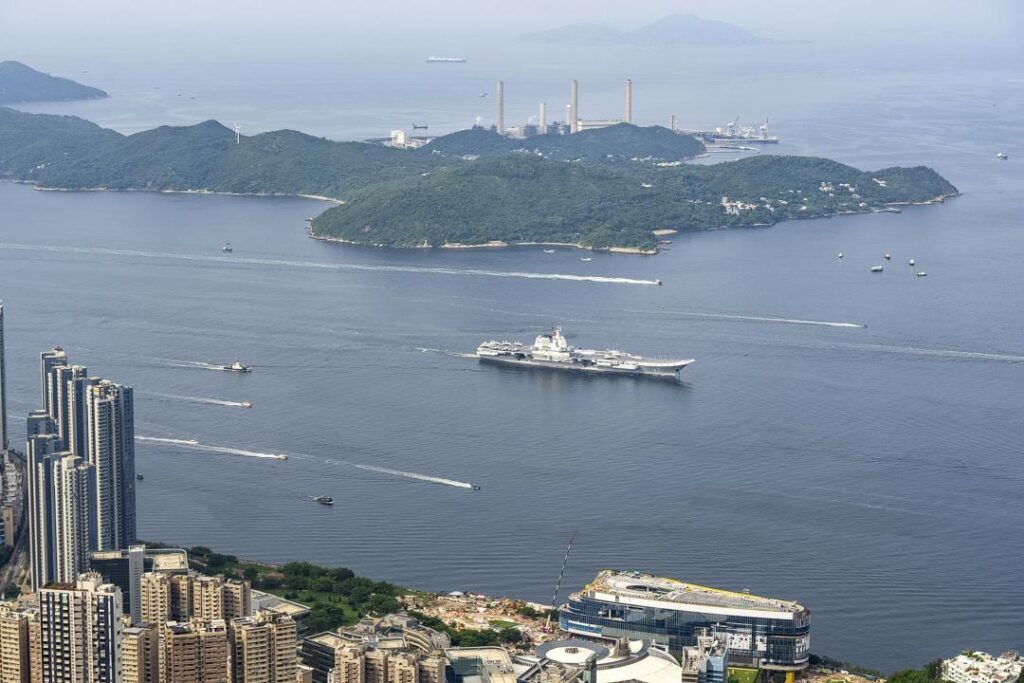
China’s first domestically-built aircraft carrier, the Shandong, made a strategic appearance in Hong Kong on Thursday, underscoring a campaign to bolster national pride. This display of military prowess comes just days after the former British colony commemorated the 28th anniversary of its return to Chinese sovereignty. The Shandong entered Hong Kong’s waters in the early morning, accompanied by another vessel from its battle group.
According to state media reports, the carrier was escorted by two destroyers and a frigate, forming a formidable naval presence.
Col. Zhang Junshe, a senior colonel with the People’s Liberation Army Navy, remarked that the warships “fully demonstrate to the outside world” China’s military advancements and will “naturally deter some forces with ulterior motives.”
Strategic Timing and Symbolism
The arrival of the Shandong is not merely a show of force but a calculated move aimed at reinforcing patriotism within the region. The timing is significant, coinciding with the anniversary of Hong Kong’s handover from British to Chinese rule—a period marked by heightened tensions and increasing calls for autonomy within the territory.
This development follows a series of assertive military maneuvers by China, both regionally and globally. The presence of the Shandong in Hong Kong waters serves as a potent symbol of China’s growing naval capabilities and its strategic interests in asserting influence over the South China Sea and beyond.
Historical Context and Military Expansion
China’s military expansion has been a focal point of its national policy for decades. The launch of the Shandong in 2019 marked a significant milestone in China’s naval development, representing a shift towards self-reliance in defense technology. Historically, China’s naval capabilities were limited, relying heavily on foreign technology and imports.
However, in recent years, China has invested heavily in its military infrastructure, with a particular focus on modernizing its navy. The Shandong is a testament to these efforts, showcasing indigenous design and construction capabilities. It reflects China’s ambition to project power and protect its maritime interests, particularly in contested areas like the South China Sea.
Expert Opinions and Global Reactions
Military analysts view the deployment of the Shandong to Hong Kong as a strategic maneuver designed to send a clear message to both domestic and international audiences. According to Dr. Li Mingjiang, an expert in Chinese military affairs, “The presence of the Shandong in Hong Kong is a demonstration of China’s growing confidence in its military capabilities. It serves both as a deterrent and a statement of intent.”
Meanwhile, regional neighbors and global powers are watching closely. The United States, in particular, has expressed concerns over China’s military expansion and its implications for regional stability. The Pentagon has frequently highlighted the need for a free and open Indo-Pacific, emphasizing the importance of maintaining navigational rights in international waters.
Implications for the Future
The deployment of the Shandong in Hong Kong waters is likely to have far-reaching implications. It underscores China’s commitment to strengthening its military presence in strategic locations and signals its readiness to defend its territorial claims. This move represents a broader trend of military assertiveness that could reshape geopolitical dynamics in the region.
Looking ahead, the international community will be closely monitoring China’s military activities and their impact on regional security. As China continues to expand its naval capabilities, questions remain about the potential for conflict and the future of international relations in the Asia-Pacific region.
In conclusion, the arrival of the Shandong in Hong Kong is a vivid illustration of China’s strategic ambitions. It not only showcases the nation’s military achievements but also serves as a reminder of the complex interplay of power and politics in the region. As China continues to assert its influence, the world watches with keen interest, aware of the significant implications for global stability.





